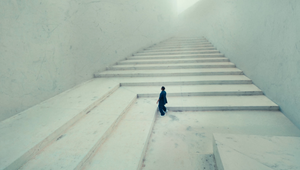
Kim Gehrig: How Film Craft Makes an Idea Outstanding

“There’s always a question on the Film Craft jury as to what the difference is between the film and the film craft,” says Somesuch director Kim Gehrig, speaking to LBB at Cannes Lions.
After a press conference where she said that “film craft is alive and well across the world,” the celebrated director and jury president for this year’s Film Craft Lions sat down with LBB’s Ben Conway to discuss what it takes to succeed in the category, her own Grand Prix-winning work from this year, and why the judging process made her a better director.
Discussing how her jury identified the key focuses that would make the ‘Film Craft’ category distinct from the ‘Film’ Lions, she shares that they devised a unique way of thinking. This method centred on one phrase: ‘How does the film craft make the idea outstanding?’.
“We’d then insert the word for each film craft,” she says. “So: ‘How does the music make the idea outstanding? Or ‘How does the animation make the idea outstanding?’. That became a very clear lens for us to determine the specific craft over the general making of the film.”
This is the process through which Kim and her jury determined the Film Craft Grand Prix winner was ‘We Cry Together’ - a short film from Park Pictures featuring rapper Kendrick Lamar and ‘Zola’ star Taylour Paige. With its raw, honest and dynamic dialogue, all captured expertly in one take, the film blurs the lines between music, theatre and poetry.
At the press conference, Kim had said, “In a world of surface visuals, the Grand Prix winner made us all feel.” Asked about the winner afterwards, she praises the “faultless direction” of the film, a challenge that she could empathise with. “I know, as a director, what would have gone into making that piece,” she says. “How to get something that is not only immaculately blocked and framed, but performed with naturalism and that feels alive, in the moment and very present. It’s an enormous feat of direction that gives me the prickles.”
In addition to ‘how the film craft could make an idea outstanding’, Kim tells us of an additional piece of criteria that helped hone in on the very best work. While judging, she was looking out for films that were made possible by the modern era in which we exist today. “I was keen to make sure [the winners] felt 2023,” she says, explaining that by ‘2023’, she means work that “feels fresh and uses craft in ways that maybe haven’t been used before.”
That’s not to say that the winners had to use the latest AI-powered, 360-degree, metaverse or virtual production technologies. “That could be traditional craft-making - and there are some winners who used traditional crafts but in maverick ways,” she says. “But occasionally we’d ask each other: ‘Could this have been made in 1983?’. If the answer was ‘maybe’, the piece may have earned a shortlist or bronze for Craft - because the craft was faultless - but maybe it wasn’t inspired in its use of that craft.”
One piece from Cannes that does feel undeniably ‘2023’ is Kim’s own film for Apple, which won a Grand Prix in the Entertainment Lions for Music. Titled ‘The Greatest’, the piece showcases Apple’s accessibility features and innovations, soundtracked by the various disabled stars of the film. Inclusivity and accessible design were big talking points at the festival this year, and something that Danielle Hinde, jury president of the category and owner and EP at Doomsday Entertainment, highlighted when announcing the winners at a press conference earlier in the week. She said, “It celebrated diversity and inclusion but not in an exploitative way - which a lot of pieces can do.”
Kim echoes Danielle’s message and says that she hopes inclusivity will one day simply become part of the work. “What I tried to do with ‘The Greatest’ was to make it an empowering piece of work for people that use accessibility features, rather than a piece that made you feel sorry for anybody.” Speaking from her own experience, conversing with and getting feedback from people on the topic, she says, “I’ve had people say to me that they’ve often found it difficult to watch disability in work - and actually, I didn’t find [this piece] difficult to watch, I found it fun to watch.”
She adds, “That was the very point - to start to make work that is celebratory, fun, empowering and that is cool, where inclusivity is part of the fabric of the creative, rather than separated in some way.”
As well as the opportunity to congratulate and showcase work that is pushing the creative boundaries and being used for good causes - such as empowering and including people who require accessibility features - Kim also believes that the judging process has benefits for the jurors too.
For those lucky enough to preside over the judging at Cannes - or any other awards show for that matter - Kim says it’s a chance for creatives and directors alike to take a purposeful look at the industry’s elite output from the last year and be inspired. This is especially poignant for Kim, as she admits to being relatively closed off to her peers’ work throughout the year, in the hopes of preserving the unique perspective she brings to her craft.
“I definitely left the room feeling like a better director, in relation to a lot of the work,” she says. “As a director, I’m very blinkered. I exist in my own hole and I make my work - and I often choose to not see other people’s work because I want what I make to come from me and be original. So I often ignore other people’s work.
“For me to go into the jury room and see other people’s work and see it in a way that I’m committed to it and committed to that screen, I just learned a lot.”















